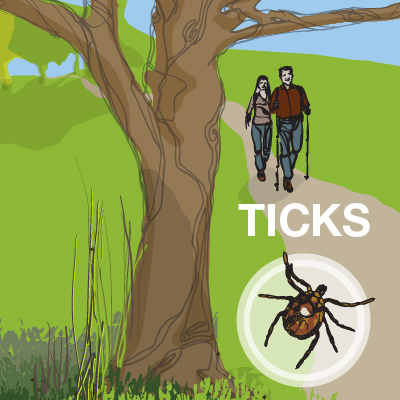 To make sure your visit to a Missouri state park or historic site is an enjoyable experience, you should know about ticks and ways to prevent problems associated with them.
To make sure your visit to a Missouri state park or historic site is an enjoyable experience, you should know about ticks and ways to prevent problems associated with them.
Ticks are most often encountered in areas of tall grass and thick vegetation during the spring and summer months. Ticks also congregate in areas where animals frequent, such as animal-created paths in natural habitats. Tick bites can be avoided by following simple guidelines.
What precautions should I take?
- Wear light-colored clothing so all ticks can be seen easily. Do not wear sandals or open-toed shoes when hiking in vegetation.
- Wear long pants tucked into boots or socks.
- Several brands of insect repellent have proven effective against ticks. Be sure to apply it to your shoes, socks, cuffs and pants legs.
- Check your clothes periodically for ticks. The deer tick in its nymph stage (also called seed ticks) often can be mistaken for a freckle or a speck of dirt.
- Do a complete body check after you have walked or hiked through any vegetation. Check your scalp carefully.
- Stay on trails and away from areas of tall grass and vegetation.
How do I remove a tick if I find one?
- Promptly and carefully remove all ticks by gently but firmly pulling them straight out with a pair of tweezers. If you must use your fingers, grasp the tick with a piece of tissue.
- Firmly grasp the tick as close to your skin as possible. Avoid squeezing the tick's abdomen. Crushing the tick could inject infectious fluids into your system.
- Duct tape or other tape may be effective in removing seed ticks.
- Clean the area with soap and water and alcohol.
- Watch it for several weeks for any symptoms. If symptoms develop, seek immediate medical attention.
What symptoms should I Watch for?
A tick-spread disease is often difficult to diagnose. The symptoms are very similar to other illnesses.
- In many cases, a rash or skin lesion will develop a short time after the bite. Sometimes there is redness near the affected area. Other common symptoms include fatigue, stiff neck and flu-like symptoms such as headache, chills, fever, sore throat, swollen lymph nodes and muscle aches.
- Untreated, these early signs may disappear but other symptoms, such as heart problems and arthritis, may occur in the months or years that follow.
Antibiotics are effective for nearly all tick-borne diseases. The key is early detection and treatment.
For more information on ticks in Missouri, please visit the Department of Health and Senior Services website or contact your local health department.





